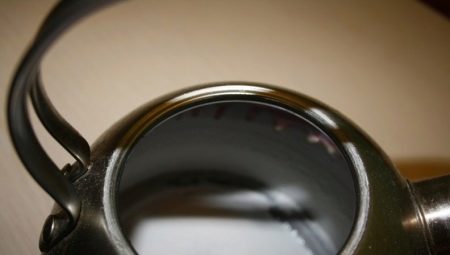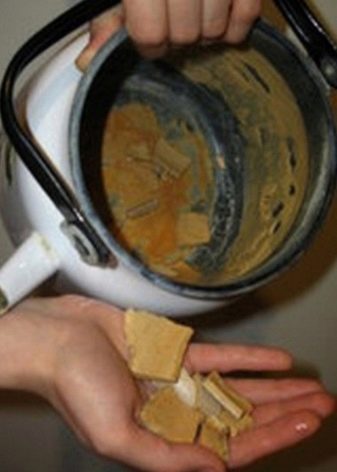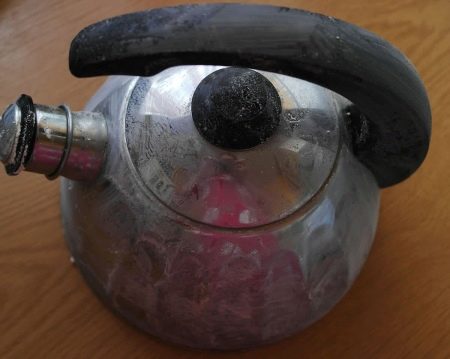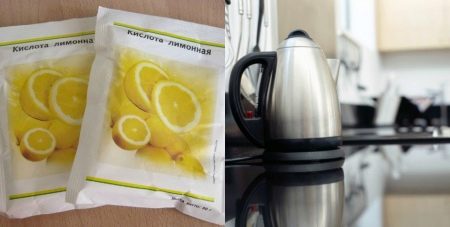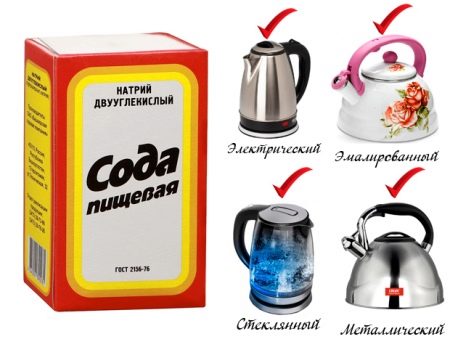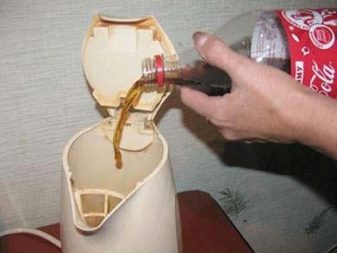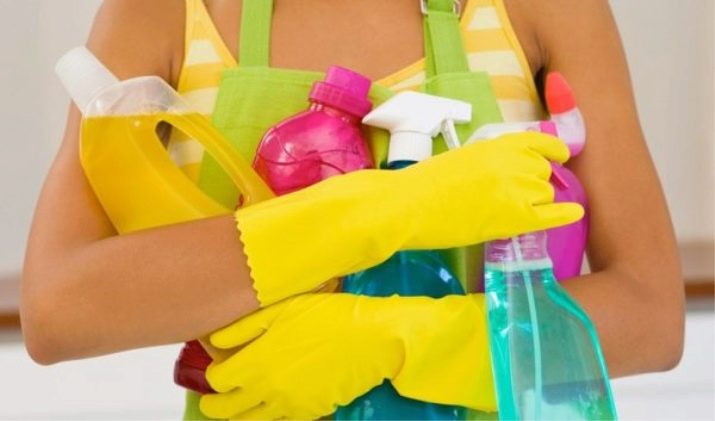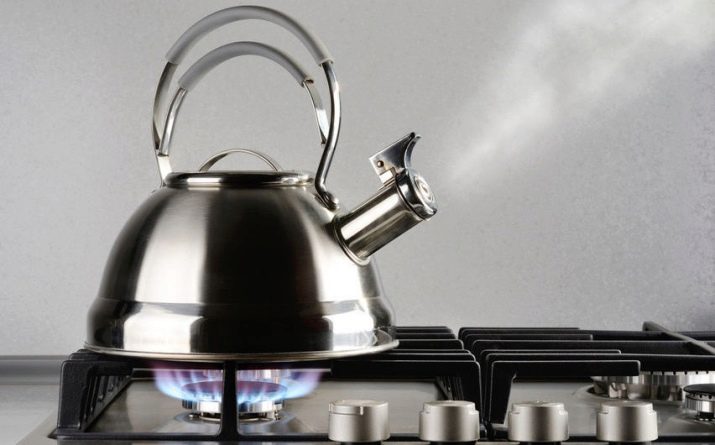Housewives and cooks often choose stainless steel dishes for use in their kitchen. Such dishes have a peculiar and beautiful appearance that requires appropriate care. In this article, you will be told in detail about the means by which means and popular councils can get rid of scale and other impurities on a stainless steel kettle.
Types of pollution
Utensils used in the kitchen for cooking or heating food and food are subject to various influences. External and internal surfaces of pots, pans or a kettle periodically transfer heat to high temperatures and contact with various products and substances.
The kettle, although it is used only for boiling water, unfortunately, also occasionally comes in improper form. You may encounter the following types of pollution from your stainless steel kettle:
- Traces of scale. Mainly formed on the inner surface of the dishes. If the water often boils and goes over the edge of the water, then such traces can affect the external surfaces. The reason for their formation lies in the composition of the water, and specifically in the minerals and salts it contains.
When boiling, these elements are evaporated from water, but do not evaporate with steam, because they have too much mass for this. Therefore, on dishes in which water is periodically boiled, we can see whitish marks or bloom.
- Fat spots on the outer surface. Drops of oil or grease may fall on the kettle from the dishes on the adjacent burners. For example, if you mix products roasting in a pan. Often we don’t attach importance to the fact that other utensils on the stove may suffer from the oil scattering when boiling.
- Black or brown soot. It is formed in those cases if you did not keep track of the kettle and simply forgot to turn off the gas on time. Then the water overflows, forming dark spots on the outer surface and bottom of the dish. If the liquid boils away completely, then carbon is formed inside the dish.
Cleaning methods
Still, do not be frightened and despair, because, as mentioned above, any dishware during use is subject to contamination and there is nothing to worry about. Using the tips given later in this article, You can easily return your original, beautiful and tidy appearance to your teapot:
- A good and versatile detergent for teapots and other dishes, including color, is laundry soap. Lather a sponge moistened with water or prepare a soap solution and wipe all surfaces of your dishes. Leave the kettle in the soapy solution for 10 minutes, then rinse it well with warm water.
- You can clean the inside of the kettle from scale or scale using acidic solutions. Diluted lemon juice, apple cider vinegar solution or citric acid can be used as acidic compounds. Table 6% apple cider vinegar must be diluted in water in a ratio of 1 tbsp. spoon per liter of water. Fill the kettle with this solution and bring the water and vinegar to a boil. After boiling, turn off the heat and wait until the water in the kettle cools and becomes warm. After that, the inside of the kettle can be wiped with a soft sponge and rinsed with water.
Acids well dissolve scale and traces of soot.
- Lemon juice or citric acid can be used in a similar way. Citric acid is dissolved in water in the ratio of 1 tsp. Of acid crystals per liter of water.Lemon juice is added to 1 liter of water in the amount of 1 tablespoon.
- You can clean the outside of the kettle from grease, scale or limescale using soda. Just avoid rubbing the surface of stainless steel utensils with dry soda powder. This can damage the material and leave noticeable stripes on it. Soda should be diluted in a small amount of water to obtain a liquid slurry, resembling semolina or sour cream.
This compound should be applied to the contaminated outer surface with a sponge and evenly distribute it. Leave the teapot covered with a gruel of soda for 15-20 minutes, then gently, without strong pressure, rub the surface with a wet sponge. Next, rinse the kettle under running water.
- You can wash off traces of scale inside the kettle by boiling soda solution in it. 1-2 tbsp. spoon of soda dissolved in a liter of water. Bring this solution to a boil in your kettle. After cooling, slightly rub the inner walls of the sponge and wash off traces of soda.
- A more popular way of advice is to use highly carbonated beverages with acids, such as Coca-Cola, Fanta, Sprite. Having filled the kettle with them and leaving it for a while, you will be able to notice how the scum starts to move away from the walls. If this does not happen, you can bring the carbonated drink in the kettle to a boil.
- Housewives often pour out pickle from under pickled vegetables, without even knowing that it can also be successfully used in combating dirt on the inner surface of dishes, including kettles made of stainless steel. Brine need to fill the dishes, bring it to a boil, turn off the gas and boil for 5-7 minutes. Scale and small soot inside the kettle can be easily removed with a sponge.
- You can always use special tools for cleaning kitchen utensils, which are sold in the departments of household chemicals. Examine the label of the cleaning composition to make sure it is valid for cleaning your type of kettle. When processing dishes with detergent, follow the instructions.
Prevention
No matter how accessible and easy to carry out methods for cleaning stainless steel kettle at home, it is still better to try to reduce the impact on the dishes of contaminating factors. More rare pollution will reduce the frequency of cleaning procedures for your kettle, saving you time and effort.
Here are a few rules that will help keep your kettle and other dishes clean in the kitchen longer:
- Try to avoid boiling the same water several times. This significantly enhances the deposition of salts and minerals on the walls of dishes. Try to approximately calculate the amount of boiling water you need, or pour off unused boiled water, applying it for other needs.
- After each boiling and draining water from the kettle, it is desirable to wipe the inner surface with a wet clean sponge. This is an easy and simple procedure that will take less than a minute, but will help to remove the invisible thin layer of scale on the walls.
- In order to avoid boiling oil and grease or other products on the external surface of the kettle, it should be removed from the stove while cooking on the adjacent burners. This is a very simple way to prevent greasy drops and stains on all types of dishes.
- If you choose chemical cleaning products and compounds for cleaning dishes, you should take care of hand protection. Be sure to use rubber gloves to protect your skin from possible allergic reactions or irritation.
- Allow the kettle to cool completely before washing the kettle. It should not be allowed that the water of colder temperature falls on a hot surface. The temperature difference between the stainless material and water can lead to microdeformations and damage to the steel. This tip is relevant for almost all types of metal and steel utensils.
We recommend to watch the video, which shows a clear example of cleaning scale in a kettle using citric acid.
